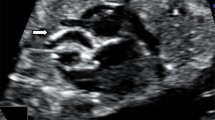Abstract
We present chest radiographs, echocardiographic image, and selective coronary angiogram of an 18-year old patient with Hutchinson–Gilford progeria syndrome.
Similar content being viewed by others
Avoid common mistakes on your manuscript.
We present an 18-year-old male patient with Hutchinson–Gilford progeria syndrome (HGPS). The patient has been followed-up in the cardiology clinic for moderate to severe aortic valve stenosis, systemic systolic hypertension, and dyslipidemia. Recently the patient complained of increased fatigue and decreased exercise tolerance. He denied any chest pain. An electrocardiogram did not show any significant changes. A chest radiograph showed rim calcification of essentially the entire aorta down to the level of the diaphragm (Fig. 1). Comparisons were made with radiographs from 3 years earlier, when no calcifications were seen. Echocardiography showed a thickened aortic valve with impaired motion (Fig. 2), severe stenosis, mild aortic valve insufficiency, and concentric left ventricular hypertrophy.
Due to increasing aortic valve stenosis and new symptoms, the patient underwent cardiac catheterization to evaluate hemodynamics as well as the patency of his CAs. Left and right ventricular end-diastolic pressures were 12 and 10 mmHg, respectively. There was only a mild gradient across the aortic valve. Pulse pressure was significantly increased; however, there was only mild aortic valve insufficiency and no aortopulmonary run-offs. Selective CA angiography showed obstruction of the left main CA and hypoplasia of the distal left circumflex and left anterior descending CAs (Fig. 3). The right CA was seen to have calcification and obstruction of its ostium and proximal segment as well as diffuse hypoplasia of the distal segments.
Although research in the field of HGPS has shown rapid progression, patient prognosis remains poor. Studies have demonstrated prominent atherosclerosis and calcification of cardiovascular (CV) structures [1], diminishing vascular function, such as increased systemic blood pressure and decreased vascular compliance [4], and decreasing high-density lipoprotein cholesterol with advancing age [3]. Death results from CV complications at an average age of 13 years [3]. Although a promising clinical drug trial with farnesyl-transferase inhibitors is underway [4], treatment options are still limited. Review of the literature resulted in only one report of CA bypass surgery with subsequent percutaneous angioplasty [2]; however, treatment continues to be targeted at decreasing CV complications and delaying myocardial ischemia. CV atherosclerotic changes have been described previously [1–4], but extensive and rapid calcification of almost the entire thoracic aorta is rather rare.
References
Baker PB, Baba N, Boesel CP (1981) Cardiovascular abnormalities in progeria. Case report and review of the literature. Arch Pathol Lab Med 105:384–386
Dyck JD, David TE, Burke B, Webb GD, Henderson MA, Fowler RS (1987) Management of coronary artery disease in Hutchinson–Gilford syndrome. J Pediatr 111:407–410
Gordon LB, Harten IA, Patti ME, Lichtenstein AH (2005) Reduced adiponectin and HDL cholesterol without elevated C-reactive protein: clues to the biology of premature atherosclerosis in Hutchinson–Gilford Progeria Syndrome. J Pediatr 146:336–341
Merideth MA, Gordon LB, Clauss S, Sachdev V, Smith AC, Perry MB et al (2008) Phenotype and course of Hutchinson–Gilford progeria syndrome. N Engl J Med 358:592–604
Author information
Authors and Affiliations
Corresponding author
Rights and permissions
About this article
Cite this article
Salamat, M., Dhar, P.K., Neagu, D.L. et al. Aortic Calcification in a Patient With Hutchinson–Gilford Progeria Syndrome. Pediatr Cardiol 31, 925–926 (2010). https://doi.org/10.1007/s00246-010-9711-z
Received:
Accepted:
Published:
Issue Date:
DOI: https://doi.org/10.1007/s00246-010-9711-z







